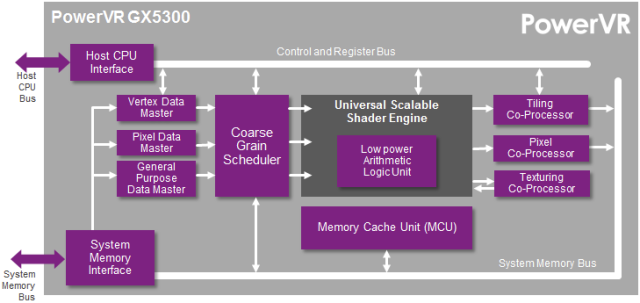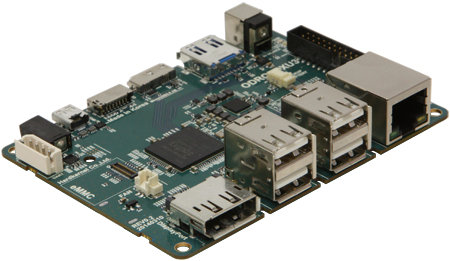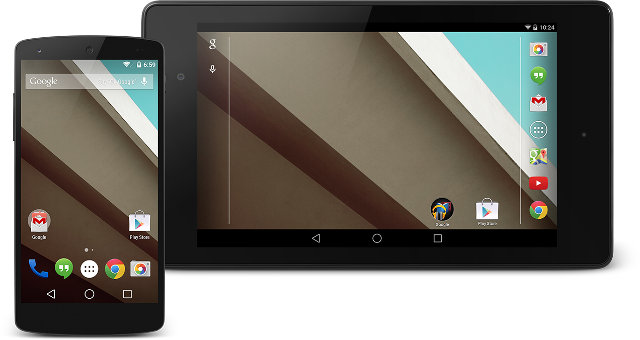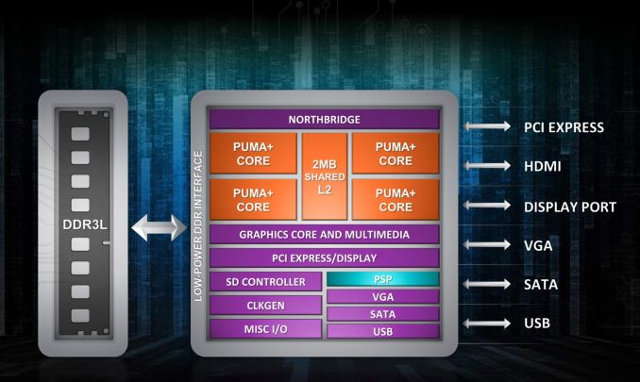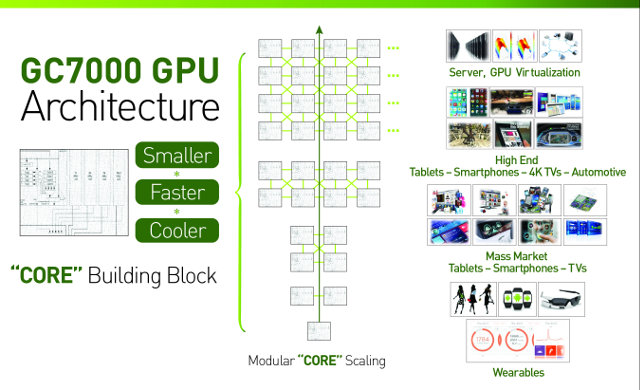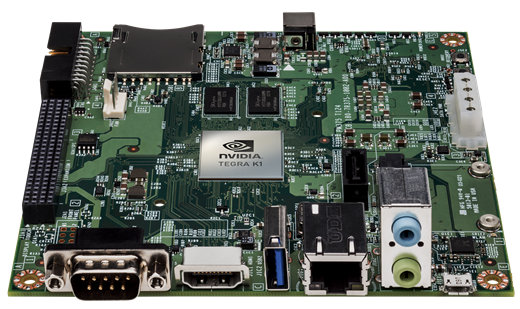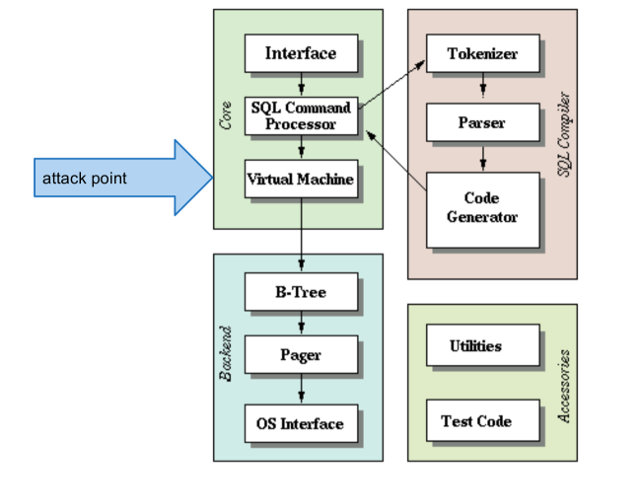Up to now most wearables are based on MCU solutions or derived from mobile platforms, which may either not provide the advanced features required by users, or consume too much power and take more space than needed. With Ineda Dhanush and Mediatek Aster, we’ve already seen silicon vendors design wearables SoCs, and now Imagination Technologies has just announced PowerVR GX5300 GPU targeting wearables with support for OpenGL ES 2.0, 480p to 720p resolution, and using 0.55mm2 silicon area based on 28nm process. PowerVR GX5300 GPU will be support Android, Android Wear, and Linux based operation systems, and according to the company has the following key features: Unified shaders – The TBDR graphics architecture offers unified shaders where vertex, pixel and GPU compute resources are scaled simultaneously. Low power and high precision graphics – All PowerVR GPUs offer a mix of low (FP16) and high precision (FP32) rendering and implement the […]
Hardkernel Unveils $179 ODROID-XU3 Development Board Powered by Samsung Exynos 5422 SoC
Remember ODROID-XU2 development board based on Exynos 5420? The bad news is that it apparently got scrapped, but the good news is that it gave birth to ODROID-XU3 development board powered by the latest Samsung Exynos 5422 octa core big.LITTLE SoC with support for Ubuntu 14.04 and Android 4.4, including GPU 3D acceleration with the company promising a full desktop experience in Ubuntu. ODROID-XU3 specifications: SoC – Samsung Exynos 5422 quad core ARM Cortex-A15 @ 2.0GHz+ quad core ARM Cortex-A7 @ 1.4GHz with Mali-T628 MP6 GPU supporting OpenGL ES 3.0 / 2.0 / 1.1 and OpenCL 1.1 Full profile System Memory – 2GB LPDDR3 RAM PoP (933Mhz, 14.9GB/s memory bandwidth, 2x32bit bus) Storage – Micro SD slot (up to 64GB) + eMMC 5.0 module socket (16, 32, or 64GB module available) Video Output – micro HDMI (Up to 1080p) and DisplayPort (up to 2160p) Audio Output – micro HDMI and […]
Google Releases Android L (Lollipop?) Developer Preview
Google I/O is taking place right now in San Francisco, and the company made several announcements. Although they have not announced the full codename of Android 5.0, referring to the next version as “Android L” (Lollipop would be nice though), but they’ve already documented the key changes made to Android L, and a developer preview will be released later today (26 June), together with binary images for Google Nexus 5 and Nexus 7. Beside the smartphone and tablet developer preview, there will be 3 other SDKs for Android L: Android Wear SDK – Android for wearables with sync notifications, wearable apps, data transfer APIs, and voice actions, e.g. “Ok Google, call mum”. Android TV Preview SDK – Android for TVs with pre-built fragments for browsing and interacting with media catalogs, in-app search, and recommendations. Android Auto SDK – Android for the car with apps featuring consistent user experience between vehicles, […]
ARM Cortex A15/A17 SoCs Comparison – Nvidia Tegra K1 vs Samsung Exynos 5422 vs Rockchip RK3288 vs AllWinner A80
We’re now starting to get quite a few players with ARM Cortex A15 cores on the market, as well as some with ARM Cortex A17. So a comparison table of different quad and octa SoCs might be a useful thing to do. I’ve put aside SoCs such as HiSilicon K3V3, and OMAP5, and focused on the four latest processors: Nvidia Tegra K1 (32-bit), Samsung Exynos 5422, Rockchip RK3288 and AllWinner A80. I haven’t included Mediatek MT6595 and Qualcomm SnapDragon 805, because the two companies mainly focus on smartphones and tablets (although it appears to be slowly changing for Qualcomm), documentation is usually difficult or impossible to find, and in the case of Qualcomm they use their own ARMv7 Krait cores. I’ve highlighted some features in green, in case a particular SoC appears to have an edge. Rockchip RK3288 AllWinner A80 Nvidia Tegra K1 Samsung Exynos 5422 CPU 4x ARM Cortex-A17 […]
AMD Unveils Low Power Mobile “Mullins” APUs for Tablets and Hybrid Laptops
AMD has announced its 3rd-generation Mainstream and Low Power Mobile Accelerated Processing Units (APUs), codenamed codenamed “Beema” and “Mullins,” respectively, featuring four x86 Puma+ CPU, AMD Radeon graphics, and a platform security processor (PSP) with an ARM Cortex-A5 core for ARM TrustZone security. Beema APUs have a TDP between 9W and 15W, whereas Mullins APUs all have less than 5W TDP (2.8W SDP). So I’ll only cover cover Mullins processors in this post, as they may offer an alternative to Intel Bay Trail-T processors. There are now 3 more APUs part of AMD’s tablets and 2-in-1 solutions: A10 Micro-6700T, A4 Micro-6400T, and E1 Micro-6200T. They are highlighted in green in the table below, and compared to previous generations: Model Radeon Brand CPU Clock Speed (Max/Base) CPU Cores on Die TDP Total L2 Cache GPU Clock Speed (Max/Base) DDR SDRMA Max Memory Speed A10 Micro–6700T Radeon R6 2.2 GHz 4 4.5W 2MB […]
Vivante Unveils Details About GC7000 Series GPU IP Family
Earlier this month, Vivante Corporation has announced several silicon partner integrations (but no names given) of its GC7000 Series GPU IP into SoCs targeting wearables, mobile, automotive, and 4K TV products, and provided some more details about its GC7000 family which supports features such as OpenGL ES 3.1 API, and hardware TS/GS/CS (tessellation / geometry / compute shader) extensions for Android. According to the company, they key benefits of their GC7000 GPU IP can be summarized as follows: True GPU Scalability – GC7000 Series products support limited silicon area to match form factor and market requirements. Products can snap to grid starting at 3.0 mm2 (28 nm) for the smallest single GPU GC7000 instance and grow in simple modular fashion for high end implementations to achieve what the company’s claims to be the the industry’s best PPA (power/performance/area). Smallest Licensable OpenGL ES 3.1 Cores with Geometry, Tessellation, and Compute Shaders […]
$192 Nvidia Jetson TK1 Development Board with Tegra K1 Quad Core Cortex A15 SoC
Nvidia has just unveiled Jetson TK1 development kit powered by their 32-bit Tegra K1 quad core Cortex A15 processor with a 192-core Kepler GPU. This board targets computer-vision applications for robotics, medical, avionics, and automotive industries that can leverage the compute capabilities of the Kepler GPU. Jetson TK1 devkit specifications: SoC – Nvidia Tegra K1 SoC with 4-Plus-1 quad-core ARM Cortex A15 CPU, and Kepler GPU with 192 CUDA cores (Model T124) System Memory – 2 GB x16 memory with 64 bit width Storage – 16 GB 4.51 eMMC memory, SATA data + power ports, full size SD/MMC slot, and 4MB SPI boot flash. Video Output – HDMI port Audio – ALC5639 Realtek Audio codec with Mic in and Line out Connectivity – RTL8111GS Realtek GigE LAN USB – 1x USB 2.0 OTG port, micro AB, 1x USB 3.0 port, A Debugging – RS232 serial port, JTAG Expansion 1x Half […]
OpenCL Accelerated SQL Database with ARM Mali GPU Compute Capabilities
We’ve previously seen GPU compute on ARM could improve performance for mobile, automotive and consumer electronics application. GPU compute offload CPU task that can be parallelized to the GPU using APIs such as OpenCL or RenderScript. Most applications that can leverage GPU compute are related to media processing (video decoding, picture processing, audio decoding, image reconigion, etc…), but one thing I did not suspect could be improve is database access. That’s what Tom Gall, Linaro, has achieved in a side project by using OpenCL to accelerate SQLite database operations by around 4 times for a given benchmark. The hardware used was a Samsung Chromebook with an Exynos 5250 SoC featurig a dual core Cortex A15 processor and an ARM Mali T604 GPU. CPU compute is only possible on ARM Mali T6xx and greater, and won’t work on Mali 400 / 450 GPUs. Other GPU vendors such as Vivante and Imagination […]


